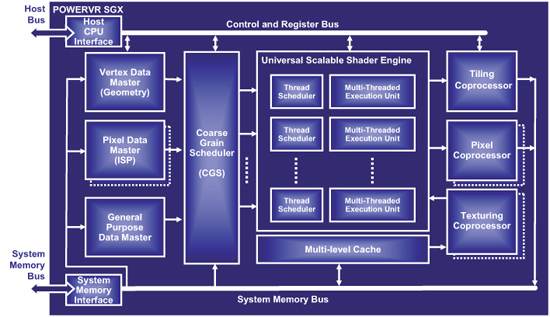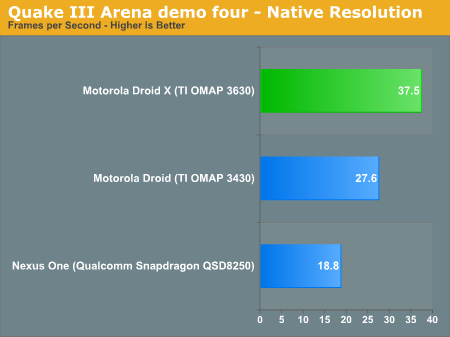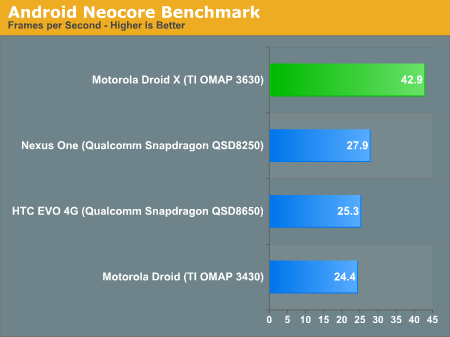Motorola Droid X: Thoroughly Reviewed
by Brian Klug on July 20, 2010 4:27 PM EST- Posted in
- Smartphones
- Motorola Droid X
- OMAP
- Mobile
The OMAP GPU - Powered by Imagination Technologies
TI continues to license its GPUs from Imagination Technologies. Rather than move to the PowerVR SGX 535 used by Apple and Intel, TI stuck with the same PowerVR SGX 530 core used in the OMAP 3430. The difference between the SGX 530 and 535 is as follows.
ImgTec refers to the execution hardware in its Series 5 GPUs as a Universal Scalable Shader Engine (USSE). Each USSE pipe can execute a 2-wide vector or up to a 4-way SIMD scalar op in a single clock. Both the SGX 530 and 535 have two USSE pipes from what I can tell.

The SGX 535 used in Apple’s A4 and Intel’s Atom Z600 series apparently have a second texturing unit and DirectX 9L support.
We’d expect that 3D apps on smartphones are more compute bound these days so it’s difficult to say how much you lose by going with the SGX 530 vs. 535. Until we get a Moorestown dev kit running Android we won’t be able to shed much light on that.
While the OMAP 3430 ran the GPU core at ~110MHz, the 3630 ramps it up to 200MHz. We’re seeing a lot of convergence around this 200MHz mark at 45nm. Intel runs the SGX 535 in Moorestown (Atom Z600 series) at 200MHz as well and I believe that’s what Apple uses in the A4 as well.
The 80% increase in GPU clock speed should result in significant real world GPU performance improvements. Just as with the CPU, there are no significant architectural changes to the GPU - it just runs faster.
The memory controller is still a 32-bit LPDDR1 interface, but can now run at up to 200MHz (the 3430 was limited to 166MHz). Should a customer choose to go for 200MHz LPDDR1 you’d get a 20% increase in memory bandwidth which will come in handy with the faster GPU in 3D apps for sure.
The GPU Performance Showdown: Snapdragon vs. OMAP 3630
When Brian first started cranking on the Droid X review he wanted to put the Qualcomm Adreno 200 vs. PowerVR SGX debate to rest. We had always reported that Qualcomm’s Snapdragon GPU was slower than the PowerVR SGX used in Apple’s A4 and TI’s OMAP 3, but we didn’t have a good idea of how much slower. Until now that is.
Armed with the Google Nexus One (Snapdragon QSD8250), Motorola Droid (OMAP 3430) and Motorola Droid X (OMAP 3630) all running Android 2.x (the N1 was running 2.2) we polished off one of the most popular GPU benchmarks of our time: Quake III Arena.
The kwaak3 project ported Q3A from a Nokia N900 version to Android. With a bit of elbow grease and getting around the lack of touchscreen keyboard support, we got the benchmark running. All scores were generated at default graphics quality settings and at native resolution, which unfortunately means the Droid X has around 7% more pixels to render than the other Android devices.

Even with the handicap, the 200MHz PowerVR SGX 530 core manages double the frame rate of the Adreno 200 in the Nexus One’s Snapdragon. Even the 110MHz SGX 530 is faster.
Here’s another interesting tidbit - we’re actually CPU bound on all of these platforms running demo four in Q3A:

Droid X (OMAP 3630) CPU utilization while running Quake III Arena
Intel is talking about greater than 100 fps frame rates with Atom Z600, meaning that the advantage is strictly on the CPU side. This also tells us that the PowerVR SGX 530 may even be a good fit for next year’s Cortex A9 based SoCs, even though TI has already committed to using the SGX 540 in its OMAP 4 line.
Neocore is another popular GPU benchmark, although this one is written for Qualcomm’s Adreno 200. The OpenGL ES 1.1 benchmark is mostly a GPU test but also stresses the platform as a whole. Running on our OMAP 3 based phones we see an average of 50% CPU utilization during the test.

The Droid X (OMAP 3630) CPU utilization while running Neocore
Interestingly enough, running the same test on a Snapdragon platform shows higher CPU utilization:

The Nexus One (Snapdragon) CPU utilization while running Neocore
The benchmark could be very well optimized for Qualcomm’s Scorpion core resulting in better CPU utilization compared to a Cortex A8.

The Adreno 200 in the Nexus One and EVO 4G outperforms the PowerVR SGX in the original Droid by 4 - 14%. This isn’t a surprise given the Qualcomm branding on the benchmark. The 45nm SGX 530 running at 200MHz puts all question to rest, the OMAP 3630 is 53% faster than Snapdragon.
The comparison here is obviously more than just GPU to GPU. We’re dealing with different CPU cores (ARM Cortex A8 vs. Qualcomm Scorpion), different memory controllers, different caches, and different drivers. Just as we’ve seen in the desktop GPU race, driver and benchmark optimizations have a lot to do with 3D performance results. I put more faith in the Quake 3 results, however those too came from a port optimized for PowerVR’s SGX.










89 Comments
View All Comments
Spoooon - Tuesday, July 27, 2010 - link
Just noticed some similarities between a "review" on CNN (http://money.cnn.com/galleries/2010/technology/100... and this one:CNN Money:
Overall, the build quality of the X is solid. Motorola has pulled off two high-end Android phones -- this and the original Droid -- that really feel good and inspire confidence. There's no give on any of the buttons, the volume buttons aren't loose and broken out of the box like some were on the original Droids, and the grippy plastic makes it feel even better. Having the phone tilt a few degrees and not rest completely flat on surfaces will help prevent the back from getting scratched up.
Anandtech:
Overall, the build quality of the X is solid. Motorola has pulled off two high end Android phones that really feel good and inspire a lot of confidence. There’s no give or play with any of the buttons, the volume buttons aren’t loose and broken out of the box like some Droids were, and the grippy plastic makes it feel even better. Again, I think having the phone tilt a few degrees and not rest completely flat on surfaces will help the back not get scratched up.
They are peppered throughout the CNN review. Maybe CNN borrowed your content with your consent?
Spoooon - Tuesday, July 27, 2010 - link
Oops. Noticed the attribution on the first page of the CNN article.LOL, I started reading it an hour ago, then stopped to work, then went back to it. :)
grkhetan - Thursday, July 29, 2010 - link
Hello, One question about the antenna chart. In the "holding naturally" column, where you touching the lower left black strip in the iphone 4?THanks
Gaurang.
brucebergman - Thursday, July 29, 2010 - link
I buy a phone to make phone calls first, be fancy second. (Fancy is nice, yes! But...) I didn't see anything on antenna analysis, or an externally accessible antenna jack should you feel the need to plug in some serious RF gain.My last two phones were the Audiovox CDM9000 and the LG VX2000, and currently is a Palm Treo 700wx. What do they have that the new crop do not? A real antenna, for those places where the NIMBY's won't allow new cell sites, and a way to connect an external antenna if you go out in the boonies a lot.
Until someone addresses this, I'm sticking with the Palm Treo. Or till it's hopelessly outdated and/or breaks and they can't find a replacement, at least.
weekilter - Thursday, July 29, 2010 - link
Too bad Moto couldn't have had the same understanding that Apple did and prevent VeriZon from putting their logos all over the device. Why the carriers think their logo adds to the appeal of a device is lost on me.myshadows - Monday, August 9, 2010 - link
Thanks for the awesome review! I may have missed this, but what is the speed of the internal 8 GB of memory compared to the Class 4 SD Card?ItsaRaid - Sunday, August 29, 2010 - link
Anand or Brian-Which would you pick?
Im trying to decide which way to go, I have a BB9700, with problems, I have looked at Both Phones the IPHone 4 and the Droid X- Im stuck- Hope maybe you can guide me as well.
Here is my Direct Contact Info:
ItsaRaid@columbus.rr.com
Hope you will take a few moments of time and help guide my decision making. Both Screens are Gorgeous and their sizes are no a big deal-
Thank You
Larry
BookDoctor - Monday, September 27, 2010 - link
I'm with you right down the line, especially regarding the length of the charging cord. Seems to me it's just another case of the supplier wanting to make an extra buck on accessories. Oh, well. . . . Nonetheless, I think the superior performance across the board makes it a small price to pay to have what's--at least in my book--the best Android device thus far.smithgood9 - Thursday, December 9, 2010 - link
As a Droid X fan, I find it useful to me. I wanted to transmit videos to PS3 for enjoying, but I failed. Because PS3 can only play it supports video formats. and PS3 can't support 3GP or other formats. Fortunately, I find a great Droid X video converter - Foxreal Video Converter, which can convert between various videos with excellent output quality. Use it transmit videos to MP4 and transmit videos to PS3 by DLNA function.